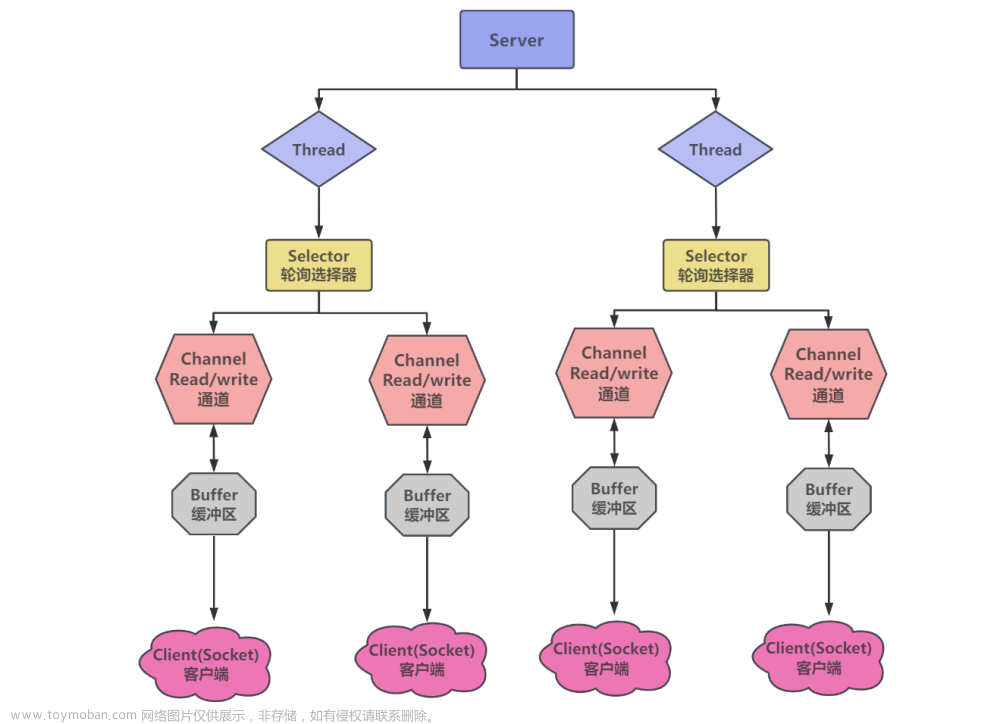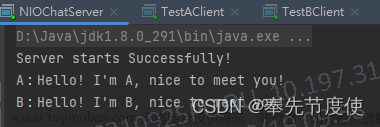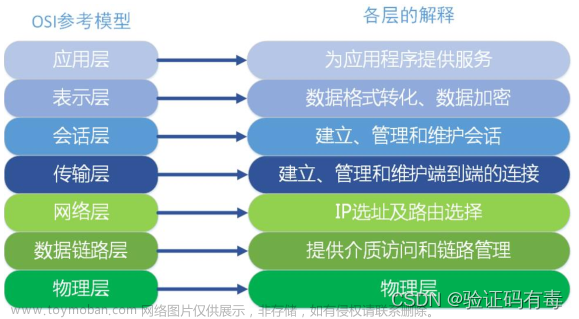highlight: arduino-light
NIO 网络编程应用实例-群聊系统
目标
需求:进一步理解 NIO 非阻塞网络编程机制,实现多人群聊
- 编写一个 NIO 群聊系统,实现客户端与客户端的通信需求(非阻塞)
- 服务器端:可以监测用户上线,离线,并实现消息转发功能
- 客户端:通过 channel 可以无阻塞发送消息给其它所有客户端用户,同时可以接受其它客户端用户通过服务端转发来的消息
服务端代码实现
/**** 监听接收和读就绪事件 1.SelectionKey是接收事件: 直接获取当前接入的客户端通道 切换成非阻塞模式 将本客户端通道注册到选择器 监听读就绪事件 移除当前接收事件对应的SelectionKey 2.SelectionKey是读就绪事件: 获取消息 转发消息到其他所有的socket,排除自己 ****/ public class Server { //定义属性 private Selector selector; private ServerSocketChannel ssChannel; private static final int PORT = 9999; //构造器 //初始化工作 public Server() { try { // 1、获取通道 ssChannel = ServerSocketChannel.open(); // 2、切换为非阻塞模式 ssChannel.configureBlocking(false); // 3、绑定连接的端口 ssChannel.bind(new InetSocketAddress(PORT)); // 4、获取选择器Selector selector = Selector.open(); // 5、将通道都注册到选择器上去,并且开始指定监听接收事件 ssChannel.register(selector , SelectionKey.OP_ACCEPT); }catch (IOException e) { e.printStackTrace(); } } //监听 public void listen() { System.out.println("监听线程: " + Thread.currentThread().getName()); try { while (selector.select() > 0){ System.out.println("开始一轮事件处理~~~"); // 7、获取选择器中的所有注册的通道中已经就绪好的事件 Iterator<SelectionKey> it = selector.selectedKeys().iterator(); // 8、开始遍历这些准备好的事件 while (it.hasNext()){ // 提取当前这个事件 SelectionKey sk = it.next(); // 9、判断这个事件具体是什么 if(sk.isAcceptable()){ // 10、直接获取当前接入的客户端通道 SocketChannel schannel = ssChannel.accept(); // 11 、切换成非阻塞模式 schannel.configureBlocking(false); // 12、将本客户端通道注册到选择器 System.out.println(schannel.getRemoteAddress() + " 上线 "); schannel.register(selector , SelectionKey.OP_READ); //提示 }else if(sk.isReadable()){ //处理读 (专门写方法..) readData(sk); } it.remove(); // 处理完毕之后需要移除当前事件 } } }catch (Exception e) { e.printStackTrace(); }finally { //发生异常处理.... } } //读取客户端消息 private void readData(SelectionKey key) { //取到关联的channle SocketChannel channel = null; try { //得到channel channel = (SocketChannel) key.channel(); //创建buffer ByteBuffer buffer = ByteBuffer.allocate(1024); int count = channel.read(buffer); //根据count的值做处理 if(count > 0) { //把缓存区的数据转成字符串 String msg = new String(buffer.array()); //输出该消息 System.out.println("form 客户端: " + msg); //向其它的客户端转发消息(去掉自己), 专门写一个方法来处理 sendInfoToOtherClients(msg, channel); } }catch (IOException e) { try { System.out.println(channel.getRemoteAddress() + " 离线了.."); e.printStackTrace(); //取消注册 key.cancel(); //关闭通道 channel.close(); }catch (IOException e2) { e2.printStackTrace();; } } } //转发消息给其它客户(通道) private void sendInfoToOtherClients(String msg, SocketChannel self ) throws IOException{ System.out.println("服务器转发消息中..."); System.out.println("服务器转发数据给客户端线程: " + Thread.currentThread().getName()); //遍历 所有注册到selector 上的 SocketChannel,并排除 self for(SelectionKey key: selector.keys()) { //通过 key 取出对应的 SocketChannel Channel targetChannel = key.channel(); //排除自己 if(targetChannel instanceof SocketChannel && targetChannel != self) { //转型 SocketChannel dest = (SocketChannel)targetChannel; //将msg 存储到buffer ByteBuffer buffer = ByteBuffer.wrap(msg.getBytes()); //将buffer 的数据写入 通道 dest.write(buffer); } } } public static void main(String[] args) { //创建服务器对象 Server groupChatServer = new Server(); groupChatServer.listen(); } }
客户端代码实现
package com.itheima.chat; import java.io.IOException; import java.net.InetSocketAddress; import java.nio.ByteBuffer; import java.nio.channels.SelectionKey; import java.nio.channels.Selector; import java.nio.channels.SocketChannel; import java.util.Iterator; import java.util.Scanner; public class Client { //定义相关的属性 private final String HOST = "127.0.0.1"; // 服务器的ip private final int PORT = 9999; //服务器端口 private Selector selector; private SocketChannel socketChannel; private String username; //构造器, 完成初始化工作 public Client() throws IOException { selector = Selector.open(); //连接服务器 socketChannel = socketChannel.open(new InetSocketAddress("127.0.0.1", PORT)); //设置非阻塞 socketChannel.configureBlocking(false); //将channel 注册到selector socketChannel.register(selector, SelectionKey.OP_READ); //得到username username = socketChannel.getLocalAddress().toString().substring(1); System.out.println(username + " is ok..."); } //向服务器发送消息 public void sendInfo(String info) { info = username + " 说:" + info; try { socketChannel.write(ByteBuffer.wrap(info.getBytes())); }catch (IOException e) { e.printStackTrace(); } } //读取从服务器端回复的消息 public void readInfo() { try { int readChannels = selector.select(); if(readChannels > 0) {//有可以用的通道 Iterator<SelectionKey> iterator = selector.selectedKeys().iterator(); while (iterator.hasNext()) { SelectionKey key = iterator.next(); if(key.isReadable()) { //得到相关的通道 SocketChannel sc = (SocketChannel) key.channel(); //得到一个Buffer ByteBuffer buffer = ByteBuffer.allocate(1024); //读取 sc.read(buffer); //把读到的缓冲区的数据转成字符串 String msg = new String(buffer.array()); System.out.println(msg.trim()); } } iterator.remove(); //删除当前的selectionKey, 防止重复操作 } else { //System.out.println("没有可以用的通道..."); } }catch (Exception e) { e.printStackTrace(); } } public static void main(String[] args) throws Exception { //启动我们客户端 Client chatClient = new Client(); //启动一个线程, 每个3秒,读取从服务器发送数据 new Thread() { public void run() { while (true) { chatClient.readInfo(); try { Thread.currentThread().sleep(3000); }catch (InterruptedException e) { e.printStackTrace(); } } } }.start(); //发送数据给服务器端 Scanner scanner = new Scanner(System.in); while (scanner.hasNextLine()) { String s = scanner.nextLine(); chatClient.sendInfo(s); } } }
尚硅谷代码实现
java package com.atguigu.nio.groupchat; import java.io.IOException; import java.net.InetSocketAddress; import java.nio.ByteBuffer; import java.nio.channels.*; import java.util.Iterator; public class GroupChatServer { //定义属性 private Selector selector; private ServerSocketChannel listenChannel; private static final int PORT = 6667; //构造器 //初始化工作 public GroupChatServer() { try { //得到选择器 selector = Selector.open(); //ServerSocketChannel listenChannel = ServerSocketChannel.open(); //绑定端口 listenChannel.socket().bind(new InetSocketAddress(PORT)); //设置非阻塞模式 listenChannel.configureBlocking(false); //将该listenChannel 注册到selector listenChannel.register(selector, SelectionKey.OP_ACCEPT); }catch (IOException e) { e.printStackTrace(); } } //监听 public void listen() { System.out.println("监听线程: " + Thread.currentThread().getName()); try { //循环处理 while (true) { int count = selector.select();//这2步可以放到while判断中 if(count > 0) {//如果有事件处理 //遍历得到selectionKey 集合 Iterator<SelectionKey> iterator = selector.selectedKeys().iterator(); while (iterator.hasNext()) { //取出selectionkey SelectionKey key = iterator.next(); //监听到accept if(key.isAcceptable()) { SocketChannel sc = listenChannel.accept(); sc.configureBlocking(false); //将该 sc 注册到seletor,监听事件为读事件 sc.register(selector, SelectionKey.OP_READ); //提示 System.out.println(sc.getRemoteAddress() + " 上线 "); } if(key.isReadable()) { //通道发送read事件,即通道是可读的状态 //处理读 (专门写方法..) readData(key); } //当前的key 删除,防止重复处理 iterator.remove(); } } else { System.out.println("等待...."); } } }catch (Exception e) { e.printStackTrace(); }finally { //发生异常处理.... } } //读取客户端消息 private void readData(SelectionKey key) { //取到关联的channle SocketChannel channel = null; try { //得到channel channel = (SocketChannel) key.channel(); //创建buffer ByteBuffer buffer = ByteBuffer.allocate(1024); int count = channel.read(buffer); //根据count的值做处理 if(count > 0) { //把缓存区的数据转成字符串 String msg = new String(buffer.array()); //输出该消息 System.out.println("form 客户端: " + msg); //向其它的客户端转发消息(去掉自己), 专门写一个方法来处理 sendInfoToOtherClients(msg, channel); } }catch (IOException e) { try { System.out.println(channel.getRemoteAddress() + " 离线了.."); //取消注册 key.cancel(); //关闭通道 channel.close(); }catch (IOException e2) { e2.printStackTrace();; } } } //转发消息给其它客户(通道) private void sendInfoToOtherClients(String msg, SocketChannel self ) throws IOException{ System.out.println("服务器转发消息中..."); System.out.println("服务器转发数据给客户端线程: " + Thread.currentThread().getName()); //遍历 所有注册到selector 上的 SocketChannel,并排除 self for(SelectionKey key: selector.keys()) { //通过 key 取出对应的 SocketChannel Channel targetChannel = key.channel(); //排除自己 if(targetChannel instanceof SocketChannel && targetChannel != self) { //转型 SocketChannel dest = (SocketChannel)targetChannel; //将msg 存储到buffer ByteBuffer buffer = ByteBuffer.wrap(msg.getBytes()); //将buffer 的数据写入 通道 dest.write(buffer); } } } public static void main(String[] args) { //创建服务器对象 GroupChatServer groupChatServer = new GroupChatServer(); groupChatServer.listen(); } } 文章来源:https://www.toymoban.com/news/detail-615434.html
java package com.atguigu.nio.groupchat; import java.io.IOException; import java.net.InetSocketAddress; import java.nio.ByteBuffer; import java.nio.channels.SelectionKey; import java.nio.channels.Selector; import java.nio.channels.SocketChannel; import java.util.Iterator; import java.util.Scanner; import java.util.Set; public class GroupChatClient { //定义相关的属性 private final String HOST = "127.0.0.1"; // 服务器的ip private final int PORT = 6667; //服务器端口 private Selector selector; private SocketChannel socketChannel; private String username; //构造器, 完成初始化工作 public GroupChatClient() throws IOException { selector = Selector.open(); //连接服务器 socketChannel = socketChannel.open(new InetSocketAddress("127.0.0.1", PORT)); //设置非阻塞 socketChannel.configureBlocking(false); //将channel 注册到selector socketChannel.register(selector, SelectionKey.OP_READ); //得到username username = socketChannel.getLocalAddress().toString().substring(1); System.out.println(username + " is ok..."); } //向服务器发送消息 public void sendInfo(String info) { info = username + " 说:" + info; try { socketChannel.write(ByteBuffer.wrap(info.getBytes())); }catch (IOException e) { e.printStackTrace(); } } //读取从服务器端回复的消息 public void readInfo() { try { int readChannels = selector.select(); if(readChannels > 0) {//有可以用的通道 Iterator<SelectionKey> iterator = selector.selectedKeys().iterator(); while (iterator.hasNext()) { SelectionKey key = iterator.next(); if(key.isReadable()) { //得到相关的通道 SocketChannel sc = (SocketChannel) key.channel(); //得到一个Buffer ByteBuffer buffer = ByteBuffer.allocate(1024); //读取 sc.read(buffer); //把读到的缓冲区的数据转成字符串 String msg = new String(buffer.array()); System.out.println(msg.trim()); } } iterator.remove(); //删除当前的selectionKey, 防止重复操作 } else { //System.out.println("没有可以用的通道..."); } }catch (Exception e) { e.printStackTrace(); } } public static void main(String[] args) throws Exception { //启动我们客户端 GroupChatClient chatClient = new GroupChatClient(); //启动一个线程, 每个3秒,读取从服务器发送数据 new Thread() { public void run() { while (true) { chatClient.readInfo(); try { Thread.currentThread().sleep(3000); }catch (InterruptedException e) { e.printStackTrace(); } } } }.start(); //发送数据给服务器端 Scanner scanner = new Scanner(System.in); while (scanner.hasNextLine()) { String s = scanner.nextLine(); chatClient.sendInfo(s); } } } 文章来源地址https://www.toymoban.com/news/detail-615434.html
到了这里,关于10.NIO 网络编程应用实例-群聊系统的文章就介绍完了。如果您还想了解更多内容,请在右上角搜索TOY模板网以前的文章或继续浏览下面的相关文章,希望大家以后多多支持TOY模板网!














